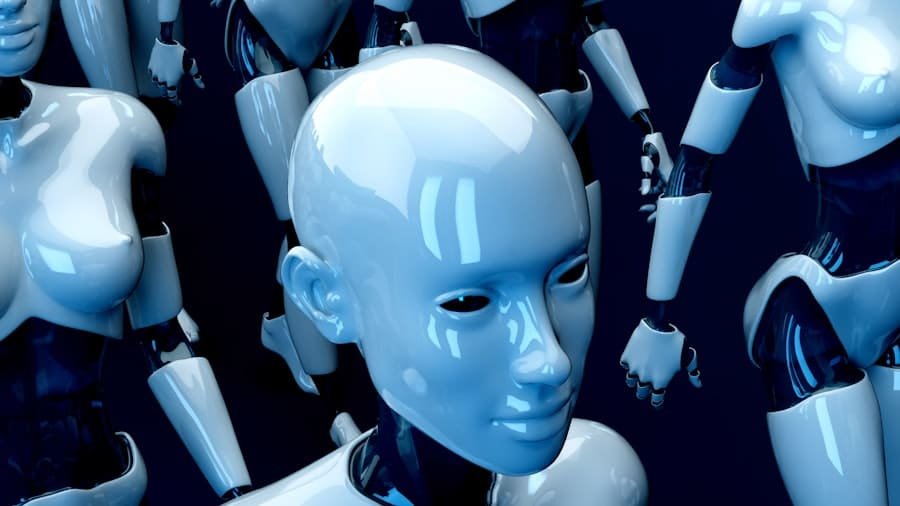Artificial Intelligence (AI) has revolutionized numerous sectors, and content creation is no exception. AI-powered content creation refers to the use of algorithms and machine learning techniques to generate written, visual, or audio content with minimal human intervention. This technology leverages vast amounts of data to produce content that is coherent, contextually relevant, and often indistinguishable from that created by human writers.
The rise of AI in this domain has been fueled by advancements in natural language processing (NLP), which enables machines to understand and generate human language with remarkable accuracy. The implications of AI-powered content creation are profound. For businesses, it offers a way to scale content production without a corresponding increase in labor costs.
This capability is particularly valuable in an era where digital marketing and online presence are paramount for success. Companies can generate blog posts, social media updates, product descriptions, and even complex reports at a fraction of the time it would take a human writer. As a result, organizations can maintain a consistent flow of content, engage their audience more effectively, and ultimately drive conversions.
Key Takeaways
- AI-powered content creation uses artificial intelligence to generate and curate content, including articles, videos, and social media posts.
- AI-powered content creation works by using algorithms to analyze data, identify trends, and create personalized and targeted content.
- The benefits of AI-powered content creation include increased efficiency, improved personalization, and the ability to generate large volumes of content quickly.
- The limitations of AI-powered content creation include the potential for errors, lack of creativity, and the need for human oversight and editing.
- Industries utilizing AI-powered content creation include marketing, e-commerce, journalism, and entertainment.
How AI-Powered Content Creation Works
At the core of AI-powered content creation lies sophisticated algorithms that analyze existing content to learn patterns, styles, and structures. These algorithms are trained on vast datasets comprising articles, books, websites, and other forms of written material. By employing techniques such as deep learning and neural networks, AI systems can identify linguistic nuances and contextual cues that inform how language is used in various contexts.
For instance, a model like OpenAI’s GPT-3 can generate text that mimics the tone and style of specific authors or genres based on the input it receives. The process typically begins with a user providing a prompt or topic. The AI then processes this input, drawing on its training data to generate relevant content.
This can include everything from simple sentences to complex narratives. The generated text can be further refined through user feedback or additional prompts, allowing for a collaborative approach between human creativity and machine efficiency. Moreover, some AI systems incorporate real-time data analysis to ensure that the content produced is not only relevant but also timely and aligned with current trends.
The Benefits of AI-Powered Content Creation

One of the most significant advantages of AI-powered content creation is its ability to enhance productivity. Businesses can produce large volumes of content quickly, which is essential in today’s fast-paced digital landscape. For example, a marketing team can use AI tools to generate multiple blog posts in a single day, allowing them to focus on strategy and engagement rather than the time-consuming process of writing.
This efficiency can lead to increased output without sacrificing quality, as many AI systems are designed to produce high-quality text that meets specific guidelines. Additionally, AI-powered content creation can help maintain consistency across various platforms. Brands often struggle with ensuring that their messaging aligns across different channels; however, AI can help standardize tone and style.
By using the same AI model for all content generation tasks, companies can ensure that their voice remains uniform whether they are posting on social media, updating their website, or sending out newsletters. This consistency not only strengthens brand identity but also fosters trust among consumers who appreciate coherent messaging.
The Limitations of AI-Powered Content Creation
Despite its many advantages, AI-powered content creation is not without its limitations. One major concern is the lack of genuine creativity and emotional depth in the content produced by machines. While AI can mimic styles and generate coherent text, it often lacks the nuanced understanding of human experiences that a skilled writer brings to their work.
For instance, an AI might struggle to convey the emotional weight of a personal story or the subtleties of humor in a way that resonates with readers on a deeper level. Moreover, there are concerns regarding the accuracy and reliability of information generated by AI systems. Since these models rely on existing data for training, they may inadvertently propagate misinformation or biases present in their training datasets.
This issue raises questions about accountability—if an AI generates misleading or harmful content, who is responsible? As such, while AI can be a powerful tool for content creation, it should be used judiciously and supplemented with human oversight to ensure quality and accuracy.
Industries Utilizing AI-Powered Content Creation
Various industries have begun to harness the power of AI for content creation, each leveraging the technology in unique ways. In the marketing sector, companies utilize AI tools to create personalized email campaigns and social media posts tailored to specific audience segments. By analyzing consumer behavior and preferences, these tools can generate targeted content that increases engagement rates and drives conversions.
The journalism industry has also seen significant advancements through AI-powered content creation. News organizations employ algorithms to generate reports on financial earnings or sports events based on data inputs. For example, the Associated Press uses AI to produce thousands of earnings reports each quarter, allowing journalists to focus on more in-depth investigative pieces rather than routine reporting.
Similarly, in the entertainment industry, scriptwriting software powered by AI assists writers in brainstorming ideas or developing plotlines by analyzing successful scripts from the past.
Ethical Considerations in AI-Powered Content Creation

As with any emerging technology, ethical considerations surrounding AI-powered content creation are paramount. One pressing issue is the potential for plagiarism or copyright infringement. Since AI systems learn from existing content, there is a risk that they may inadvertently replicate phrases or ideas without proper attribution.
This raises questions about intellectual property rights and the need for clear guidelines governing the use of AI-generated material. Another ethical concern involves transparency and authenticity. Consumers increasingly value authenticity in brand messaging; however, if they are unaware that content has been generated by an AI system, it could lead to feelings of deception or mistrust.
Companies must navigate this delicate balance by being transparent about their use of AI while ensuring that the content produced aligns with their brand values and resonates with their audience on a personal level.
Future Trends in AI-Powered Content Creation
The future of AI-powered content creation is poised for significant evolution as technology continues to advance. One trend likely to gain traction is the integration of voice and visual elements into content generation processes. As voice search becomes more prevalent and visual storytelling gains importance in digital marketing strategies, AI systems will need to adapt by creating multimedia content that engages users across various formats.
Additionally, as natural language processing technology improves, we can expect more sophisticated interactions between humans and machines. Future AI models may be able to engage in more nuanced conversations with users, allowing for real-time collaboration in content creation. This could lead to a more dynamic approach where human creativity is complemented by machine efficiency, resulting in richer and more diverse content offerings.
Tips for Implementing AI-Powered Content Creation in Your Business
For businesses looking to implement AI-powered content creation effectively, several strategies can enhance the process. First and foremost, it is crucial to select the right tools that align with your specific needs and objectives. Various platforms offer different capabilities—some may excel at generating blog posts while others are better suited for social media content or technical writing.
Training your team on how to use these tools effectively is equally important. Providing workshops or resources on best practices for interacting with AI systems can empower employees to leverage technology fully while maintaining their creative input. Additionally, establishing clear guidelines for quality control will ensure that all generated content meets your brand’s standards before publication.
Finally, fostering a culture of collaboration between human writers and AI tools can yield the best results. Encourage your team to view AI as an assistant rather than a replacement; this mindset can lead to innovative approaches where human insights enhance machine-generated content. By embracing this synergy, businesses can unlock new levels of creativity while benefiting from the efficiency that AI offers in content creation.
If you’re interested in exploring how AI can enhance various aspects of business, including content creation, you might also find value in understanding how businesses can maintain security when employees work remotely, a challenge that has become increasingly relevant. The integration of AI tools can play a significant role in ensuring data security and efficient workflow in such setups. For more insights on this topic, consider reading the article on how to maintain security when employees work from home. This piece provides useful strategies that can help businesses protect their data and maintain productivity as they adapt to remote working environments.
FAQs
What is AI-Powered Content Creation?
AI-powered content creation refers to the use of artificial intelligence technology to generate written or visual content. This can include anything from writing articles and blog posts to creating images and videos.
How does AI-Powered Content Creation work?
AI-powered content creation works by using machine learning algorithms to analyze and understand large amounts of data. This data is then used to generate new content that is relevant and engaging for a specific audience.
What are the benefits of AI-Powered Content Creation?
Some of the benefits of AI-powered content creation include increased efficiency, the ability to generate large amounts of content quickly, and the potential for more personalized and targeted content.
What are some examples of AI-Powered Content Creation tools?
Some examples of AI-powered content creation tools include natural language generation platforms like OpenAI’s GPT-3, content optimization tools like MarketMuse, and image and video creation tools like Canva and Lumen5.
Are there any limitations to AI-Powered Content Creation?
Some limitations of AI-powered content creation include the potential for content to lack a human touch, the need for human oversight to ensure quality and accuracy, and the risk of creating content that is too generic or formulaic.
